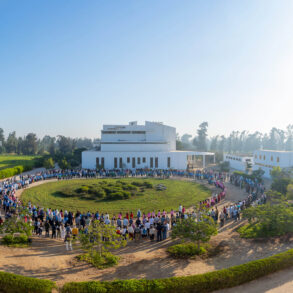Goodness does not allow itself to be possessed; it is a threshold of Being that we must cross in order to find it.
I have always loved the word goodness: goodness as a character trait, as a disposition towards the world—not so much as a seal of approval, a “conditional trustworthiness.” I have always been more sympathetic to goodness than the good. It’s near to the soul, to the ‘I,’ to the human being. The good is the object of intellectual debate; goodness lives in the chambers of the heart.
And “my” goodness, we ask ourselves? Our own? When have we offered a goodly part of our possessions or tried to make good in some social situation? Even with these variations in the semantic field, the innocence of the concept is already lost. Who would say that goodness is their own quality, the substance of their own being? Rather, it’s an invisible casula1 that lies over us like grace and calms the waves of emotions and pricks of righteousness for a moment. Yet, those who always want to make things good don’t seem able to bear disharmony. Beauty is not created by whitewashing either. Do they not want to see the black talar of earthly imperfection and, instead, put the alba of indulgence over everything?2 Is the good to do what is good or to do what is necessary?
The opposite of good intentions is well known. Modernity has also taught us that the good is never static or eternal (just as truth requires truthfulness). It’s valued as the middle between extremes, which is revealed by its absence and whose absence is felt. Does the good only reveal itself in the perception of its absence?
Goodness Heals Ambivalence
In conflicts, I’ve often stood between positions that I understood equally well. I’ve felt powerless, not knowing whether to stand up or give in, to be hard or soft. This is regarded as not good and hardly socially congenial. Even the greatest advocate of “both/and” will not be able to avoid making decisions on this Earth. There’s no such thing as an incarnation that remains hovering between spirit and body. In such constellations, one learns to consider oneself complicated and indecipherable. If one gives their word, it has too little flesh. The concrete, etymologically comprehensible, ostensible, or actual, seems abstract—something drawn out, only derivative, and distant.
Nevertheless, hesitation can be honest and necessary. To this day, when in doubt, I always want to be good to a human being who has done something foolish or “evil” or has lost themselves in the hell of possible courses of action. The good human being doesn’t need my goodness.
If even with the best of intentions, I don’t know what good would be best in an argument, the good still knows me and makes itself known, tenderly—without “showing” it to me. Everything then depends on whether we realize the goodness of the good. There is nothing more beautiful than being worn out by evil, by strife! Not yet wholly redeemed, but at peace. Perhaps, you don’t even know whether goodness gently took the weapon out of our hand—or evil itself. As if evil had fulfilled its task: to exhaust us, so that we find the force to face each other anew.
As children, we ought to first experience the world as true and be able to experience its beauty and not its caricature or morbidity. Those who are older don’t have to share their own doubts with those entrusted to them. Which is why, irrespective of all else, we need reliable criteria of judgment, not only airy ideals, and, as adolescents, we need role models by which we can orient ourselves. Perhaps afterward, when we’ve had such a counterpart, we can develop our own techniques to activate individualism and phantasy in the moral dilemmas of everyday life.
Or does that not ring true anymore? In the present younger generation, are many children already living with a counterpart within themselves? I observe in my thirteen-year-old daughter that she tends to be extra alert and watchful, and people like her have long been habitually and casually teaching us parents what is right. As if something has changed; as if young people today are no longer freeing themselves from societal authorities or predetermined good intentions, but rather embodying them. The shadows of social media still seem completely clear to everyone, as surely as they are being constantly and correctly talked about: everything is integrated into ethical coordinate systems early on and is perpetually reflected upon (ironically, in a detached way) in communication systems running in parallel.
In view of such developments, it may be all the more sensible to keep alive the sensitivity and consciousness for in-between spaces. The good is fleeting, it’s time-bound, and it can change camps all too quickly, depending on perspective and necessity. What is considered right, healthy, or normal today may be considered unhealthy, wrong, or sick tomorrow. Goodness, on the other hand, is ultimately always creative. It works beyond probing questions, such as: which side are you on? It calms all the discussion, commentary, and evaluation of the actions of others.
The Good Passes Away and Is Ever New
The good doesn’t work out like an equation. You can’t count on it just because you have passed a law on what it is. It rises like the sun; it dawns upon us. It lives less in demands than in requests, intuitive requests, in the radical pause of conscience that goes to the root. It’s not a flowering of discourse but rather the wind that sweeps across the wide field of times and opinions, across dry deserts or lush meadows. It’s what happens between the lines and between the years. The good is what gets in the way of the power that’s planning a war, the stream of life between deadlines, the little accident that destiny lovingly arranges to wake us up. If someone wants to rule by pushing through policies, the good is the stick in the spokes. The good is the fighter pilot who’s supposed to open the hatch and destroy a village, but who apologizes over the radio for being a bit off because he’s in love. It’s the soldier who lowers her rifle because she’s distracted by a philosophical insight. The good that’s meant here never stops bringing to the world ways to change one’s life and to love one’s neighbor, fundamentally and always.
Goodness gives birth to good, which is mortal, for it’s bound to human beings, to concrete situations and moments, to a soul that empathizes and that sends itself across the very threshold that the good must avoid in order to remain good: the threshold, where heaven and hell merge into one another—eternity and temporality, birth and death, one’s own ‘I’ and the ‘I’ of another. In this respect, goodness, in itself, is always transhuman.
Only on the thresholds do we pause and really confront ourselves. We sense our essence and hear a voice that whispers: Don’t finish each other off just because you’re unfinished. Don’t let yourselves be artificially perfected out of impatience or hubris. There are reasons to think that human beings may be good. But don’t perfect yourselves at the push of a button, but gradually, in life, like the thoughts within ensouled speech. Or like a love, in which no one has even a single cent invested. So, may each and every one learn to be good to ourselves.
Translation Joshua Kelberman
Image Painting by Ulrich Schulz, “Himmel” [Sky/Heaven] 2017. Watercolor. Canvas, glue, ash, marble, plant colors, pigments.
Footnotes
- A Casula is a square garment, originating in Roman times, with a whole cut out for the head, similar to a poncho.
- A Talar is a long robe, reaching down to the ankles, similar to those worn by judges or graduates; An Alba is a white robe reaching the feet and covering the whole body, worn by clergy, etc.









